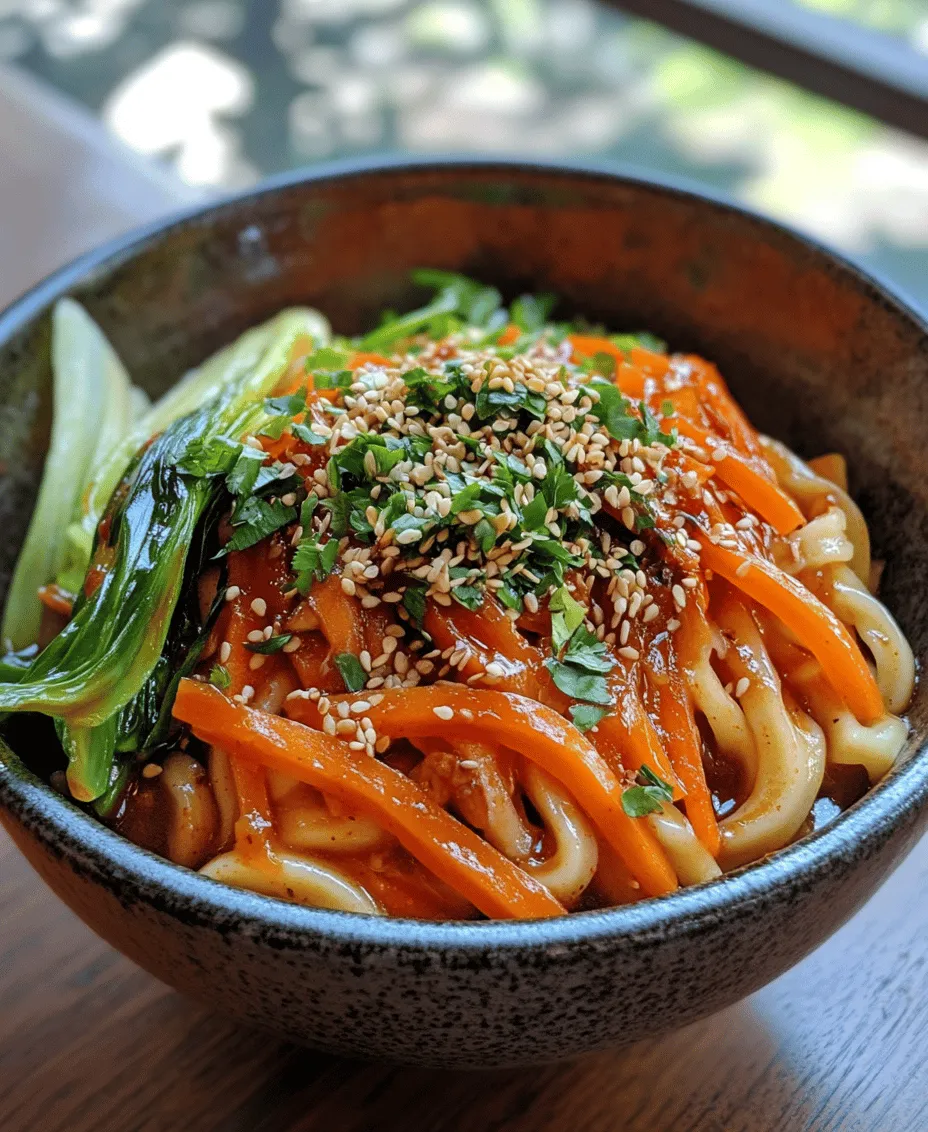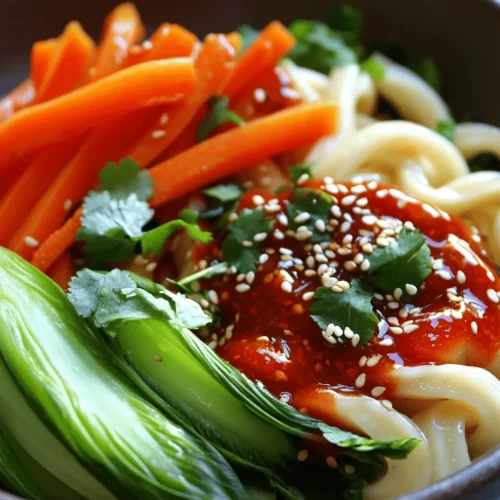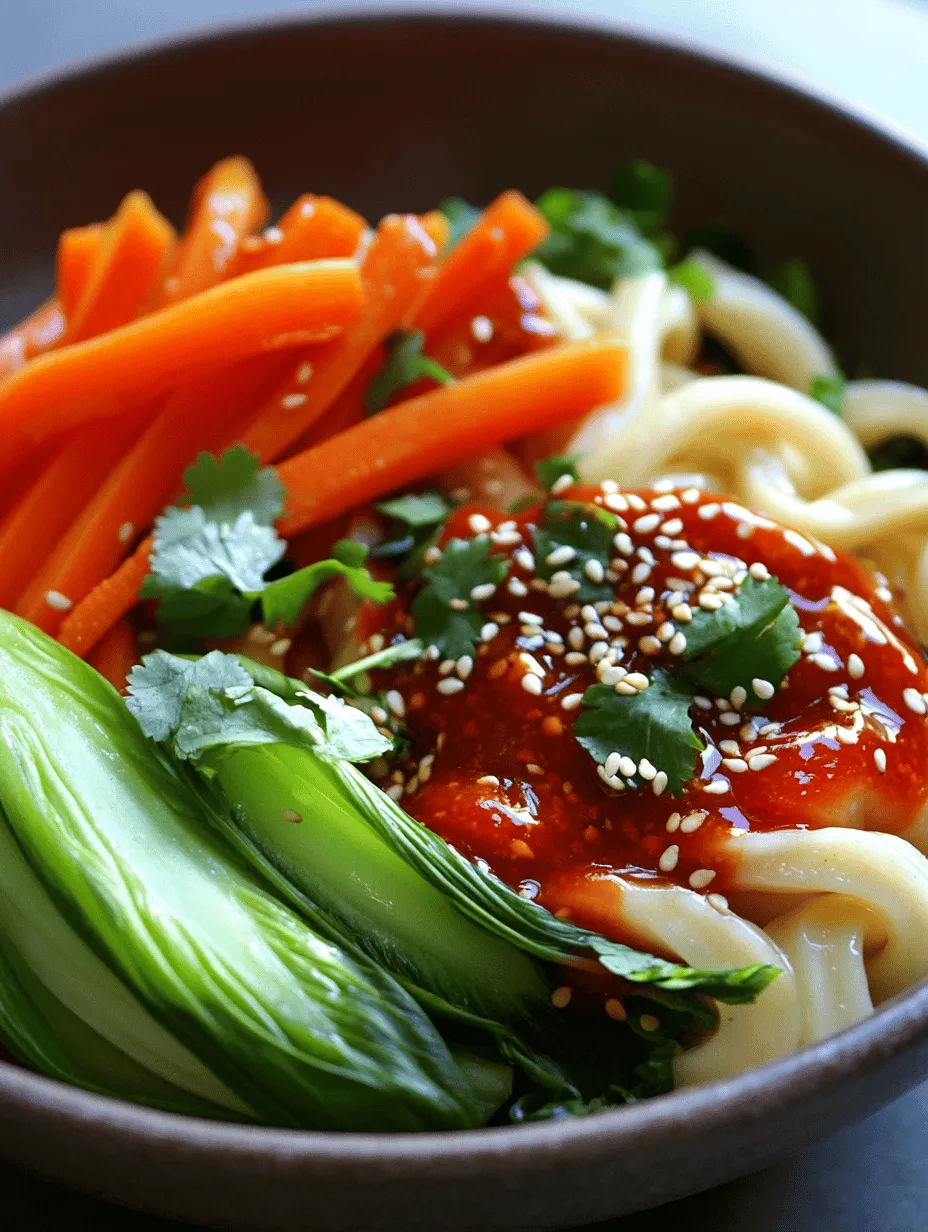Introduction
In the hustle and bustle of modern life, finding time to prepare meals that are both quick and delicious can often feel like a daunting challenge. Enter the 10-Minute Chili Oil Udon Noodles—a dish that not only fits seamlessly into your busy schedule but also offers an explosion of flavor that will tantalize your taste buds. This simple yet satisfying recipe is a testament to the fact that you don’t have to compromise on taste even when you’re pressed for time.
Udon noodles, the star of this recipe, are thick, chewy Japanese noodles that serve as a perfect base for a variety of toppings and sauces. Their versatility makes them a staple in Asian cuisine, and they can be enjoyed in both hot and cold dishes. With just a few ingredients and minimal preparation, you can create a comforting bowl of udon noodles that is both nourishing and bursting with flavor.
As we delve into this recipe, we’ll explore not just the cooking process, but also the cultural significance of udon noodles and chili oil, making this journey as enriching as it is delicious. Let’s get started!
Understanding Udon Noodles
Udon noodles are a type of Japanese noodle made from wheat flour, water, and salt. They are characterized by their thick, chewy texture, which makes them incredibly satisfying to eat. Unlike their thin counterparts, the texture of udon allows them to hold up well against rich sauces and broths, making them a versatile choice for a variety of dishes.
One of the most appealing aspects of udon noodles is their nutritional profile. They are a good source of carbohydrates, providing energy for those with active lifestyles. Compared to other types of pasta, udon noodles are generally lower in calories and fat, making them a healthier option for those looking to maintain or lose weight. Additionally, the presence of whole wheat udon noodles on the market offers even greater health benefits, including increased fiber content, which aids in digestion.
Udon noodles are popular in various Asian cuisines, especially in Japan, where they can be served hot in a savory broth or cold with a dipping sauce. The adaptations of udon are endless—whether you prefer them in a hearty soup, stir-fried, or dressed with a flavorful sauce, they are sure to please any palate. This recipe for Chili Oil Udon Noodles is just one of many ways to enjoy these delightful noodles.
Chili Oil: The Heart of Flavor
At the heart of this dish lies chili oil—a vibrant condiment that brings depth and warmth to every bite. Originating from Chinese cuisine, chili oil has gained popularity worldwide for its ability to enhance the flavor of countless dishes. It is made by infusing oil with chili peppers, garlic, and spices, resulting in a rich, aromatic oil that can range from mildly spicy to fiery hot.
Chili oil not only adds a kick of heat but also contributes a complex flavor profile that can transform a simple bowl of noodles into a culinary masterpiece. Its cultural significance cannot be overstated; in many Asian households, chili oil is a staple condiment that is drizzled over everything from dumplings to rice. The versatility of chili oil makes it a must-have in any kitchen, and it can be easily adjusted to suit your personal heat preference.
You can either make your own chili oil at home, allowing you to control the ingredients and spice level, or purchase it from stores where various types are available. Homemade chili oil often contains additional spices and aromatics, giving it a unique flavor that can elevate your dishes. Whether you choose to make it from scratch or use store-bought, chili oil is sure to be the star of your udon noodle dish.
Ingredient Breakdown
Now that we’ve established the foundation of our dish, let’s take a closer look at each ingredient that will come together to create these delectable 10-Minute Chili Oil Udon Noodles.
Fresh Udon Noodles
When it comes to udon noodles, freshness is key. Fresh udon noodles are typically made with a higher moisture content than dried varieties, which contributes to their chewy texture and rich flavor. They cook quickly, making them ideal for a fast meal like this one. You can find fresh udon noodles in Asian grocery stores or in the refrigerated section of many supermarkets. If fresh noodles are unavailable, you can substitute with dried udon noodles, but be sure to follow the cooking instructions on the package for the best results.
Chili Oil
As mentioned earlier, chili oil is the heart of flavor in this dish. When selecting chili oil, consider the heat level that you prefer. Some brands offer mild options, while others pack a punch. If you’re making your own, you can customize the heat by adjusting the amount of chili flakes used. Additionally, some chili oils include aromatic ingredients like garlic and ginger, which can enhance the overall flavor of your udon noodles.
Soy Sauce
Soy sauce is a crucial ingredient in many Asian dishes, including our udon noodles. It adds umami depth and a savory richness that complements the other flavors in the dish. There are various types of soy sauce available, such as light, dark, and tamari. For this recipe, light soy sauce is recommended for its balance of saltiness without overpowering the other ingredients. Alternatively, if you prefer a gluten-free option, tamari soy sauce can be used without sacrificing flavor.
Sesame Oil
Another essential ingredient in this recipe is sesame oil. This fragrant oil brings a nutty flavor that enhances the overall taste of the dish. It is commonly used in Asian cooking and adds a unique depth to the udon noodles. A little goes a long way, so use it sparingly to avoid overwhelming the other flavors. Sesame oil is also known for its health benefits, including being high in antioxidants and healthy fats.
Garlic and Ginger
Garlic and ginger are aromatic powerhouses that contribute to the overall flavor and fragrance of the dish. Freshly minced garlic adds a pungent, slightly sweet edge, while ginger brings a warm, slightly spicy note that complements the chili oil beautifully. Together, these two ingredients elevate the flavor profile of the udon noodles, making each bite more aromatic and satisfying.
Vegetables
To add nutritional value and vibrant colors to your dish, incorporating vegetables is highly recommended. Options like bok choy, bell peppers, and scallions not only provide essential vitamins and minerals but also enhance the dish’s visual appeal. Feel free to use whatever vegetables you have on hand or prefer—this recipe is incredibly adaptable.
The Garnishes
Finally, garnishing your Chili Oil Udon Noodles can take the dish from great to extraordinary. Toasted sesame seeds add a delightful crunch and nutty flavor, while fresh cilantro brings a burst of freshness that balances the richness of the noodles. These simple garnishes not only enhance the visual presentation but also contribute additional layers of flavor that make the dish memorable.
In the next section, we will dive into the detailed instructions for preparing these delicious 10-Minute Chili Oil Udon Noodles, guiding you through each step to ensure a successful outcome. Get ready to bring the flavors of Asia into your kitchen!

Step-by-Step Cooking Instructions
To create the perfect 10-minute chili oil udon noodles, precision and timing are key. Let’s break down the process step by step to ensure your dish is a delightful blend of flavors and textures.
1. Cooking Udon Noodles
Begin by bringing a large pot of water to a rolling boil. Make sure to use plenty of water to allow the noodles to cook evenly. Once the water reaches a boil, add the udon noodles—typically, these take about 3 to 5 minutes to cook. Stir gently to prevent the noodles from sticking together. It is crucial to taste the noodles a minute or two before the package time to check for doneness; you want them to be tender yet firm, or “al dente.” Once cooked, drain the noodles in a colander and rinse them briefly under cold water. This stops the cooking process and helps maintain the perfect texture.
2. Preparing the Sauce
While the noodles are cooking, prepare your sauce. In a small bowl, combine soy sauce, sesame oil, and your homemade or store-bought chili oil. Taste the mixture and adjust the flavors as needed. If you prefer a sweeter touch, consider adding a teaspoon of sugar or honey. For acidity, a splash of rice vinegar can enhance the overall flavor profile. The goal is to achieve a balance between salty, spicy, and savory notes. Set the sauce aside so the flavors can meld while you sauté the aromatics.
3. Sautéing Aromatics
Heat a tablespoon of vegetable oil in a large skillet or wok over medium-high heat. Once the oil is shimmering, add minced garlic and sliced ginger. The key to maximizing flavor extraction is to sauté these aromatics just until they become fragrant, which usually takes about 30 seconds to a minute. Be careful not to burn them, as this can lead to a bitter taste. The golden-brown color indicates they are ready for the next step.
4. Stir-Frying Vegetables
Next, add your choice of vegetables to the pan. Popular options include bell peppers, bok choy, and snap peas, which offer a vibrant color and crunch. Stir-fry the vegetables for about 2 to 3 minutes, ensuring they remain crisp and bright. The high heat will help seal in their moisture and flavor. If using leafy greens like spinach, add them last, as they wilt quickly and require less cooking time.
5. Combining Noodles and Sauce
Once your vegetables are perfectly sautéed, add the drained udon noodles directly into the skillet along with the prepared sauce. Use tongs to toss everything together gently, ensuring that the noodles are evenly coated with the sauce and that all ingredients are heated through. This should take about 1 to 2 minutes. If the mixture seems dry, a splash of water or additional soy sauce can help create a silkier consistency. Serve immediately for the best texture and flavor.
Serving Suggestions
Chili oil udon noodles can be served in a variety of creative ways that enhance their appeal and flavor. Here are some suggestions to elevate your dish:
– Protein Additions: For a more substantial meal, consider adding proteins such as grilled chicken, shrimp, or tofu. Simply cook your protein of choice separately and then combine it with the noodles at the end. This not only adds flavor but also boosts the dish’s nutritional profile.
– Side Dishes: Pair your udon noodles with a light salad, such as a cucumber salad with sesame dressing, or a bowl of miso soup. These complementary dishes provide a refreshing contrast to the spicy noodles.
– Presentation Tips: When plating, consider using a large, shallow bowl. Twirl the noodles into a nest-like shape for a visually appealing presentation, and top with a sprinkle of sesame seeds, sliced green onions, or a drizzle of additional chili oil for a pop of color. Fresh herbs like cilantro or perilla leaves can also add a fragrant touch.
Nutritional Information
The nutritional profile of chili oil udon noodles can vary based on the specific ingredients used, but here’s a general breakdown per serving:
– Calories: Approximately 400-500 calories, depending on the quantity of noodles and added proteins
– Macronutrients:
– Carbohydrates: 60-70 grams
– Protein: 10-20 grams (higher if adding protein)
– Fat: 10-15 grams (mostly from the oil and sauce)
– Micronutrients: Rich in vitamins A and C from vegetables, along with calcium and iron if leafy greens are included.
Incorporating leafy greens and other vegetables not only boosts the nutritional value but also enhances the dish with fiber, essential for digestive health.
Cultural Context and Variations
Udon noodles are a staple in Japanese cuisine, known for their thick, chewy texture. They originated from wheat flour and are often served in hot broth or stir-fried. The versatility of udon has allowed it to be adopted in various cultures, leading to numerous adaptations.
For instance, in Chinese cuisine, you might find similar thick noodles stir-fried with soy sauce, garlic, and vegetables, while in Korean dishes, they may be combined with spicy sauces and seafood.
Variations of chili oil udon noodles can include:
– Protein Variations: Try adding sliced beef, pork, or even a soft-boiled egg for richness.
– Different Vegetables: Experiment with seasonal vegetables like zucchini, carrots, or mushrooms to keep the dish fresh and interesting.
– Regional Spices: Explore incorporating regional spices such as Szechuan peppercorns for a numbing heat or fresh herbs like Thai basil for a fragrant twist.
Conclusion
Creating a bowl of chili oil udon noodles is not only quick and easy, but it also offers a delightful explosion of flavors and textures that can satisfy any palate. This recipe showcases the beauty of combining simple ingredients to produce a dish that is both comforting and versatile.
Feel free to explore and customize this recipe according to your taste preferences. Whether you choose to add proteins, experiment with different vegetables, or adjust the spice levels, the possibilities are endless. Enjoy the journey of creating your own delicious bowl of chili oil udon noodles, and share your culinary creations with friends and family!



